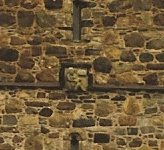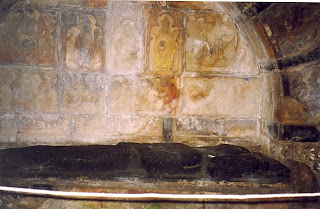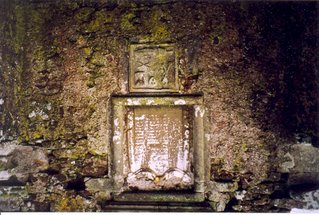St. Clement's Church dates from 1528, at Rodel. Harris. It was dedicated to Alexander MacLeod, who was known in Gaelic as Alasdair Crotach of Dunvegan. MacLeod died twenty years later.
Sources: See http://www.treasuredplaces.org.uk/gallery/detail.php?id=82&view=®ion=10/; http://www.scotland-inverness.co.uk/rodel.
Our route:
We used the car-ferry from Portree, on the Isle of Skye, see the map at http://www.undiscoveredscotland.co.uk/usmapindexes/westhighlands.html/. Leaving in the late afternoon, we arrived att Tarbert, Harris, www.undiscoveredscotland.co.uk/usmapindexes/westernisles.html, just at dusk.
Ferry time: just about two hours. We had called ahead for B&B from Skye because it would be dark when we arrived. There is a long, narrow road from Tarbert to Rodel, with a moonscape-rock-boulder twisting way through steep-sided places to Rodel. People drive methodically there, and headlights give you warning. Still, it is a dicey drive.Our B&B was an easy find once there. See www.visithebrides.com/islands/harris/
Look closely at the tower of St. Clement's tower. There is what some would call a sheelanagig. Thre is a website that catalogues these at www.sheelanagig.org/, and you can see the telephoto lens close-up: there. It is a woman giving birth. Our photo is less clear.
 Sheelanagig, woman giving birth, tower at St. Clement's Church, Rodel, Harris, Hebrides
Sheelanagig, woman giving birth, tower at St. Clement's Church, Rodel, Harris, HebridesThese sheela-na-gigs are usually Irish or English forms, some celtic and pre-celtic, others seen as fertility-type forms at crossroads or on buildings, or at churches. This one is from much later. As holdovers from earlier religions and traditions, they were not totally dismissed with institutional Christianity.
St. Clement's Church is 15th-16th Century, but the sheela-na-gig on the tower really looks far older, perhaps a component of another structure incorporated in the newer tower. It does not appear to me to be the Christian virgin and child as some sites say, see //www.scotland-inverness.co.uk/rodel.htm. She is not sitting with knees together there. See www.sheelanagig.org/. This looks more fertility oriented. Novelists: who will be the first to write of a secret traditions of the Hebrides as a safe havens for fleeing figures from the holy land?
There is a long tradition of sheelanagigs - many are almost grotesque, others simply showing a fact of life and in a dignified and not exaggerated way.
We all see what we want to see, and it certainly keeps tourists' attention away if you just tell people it is another virgin and child. See post on sheela-na-gigs, the outside of St. Clement's here.
 St. Clement's Church, Rodel, Harris
St. Clement's Church, Rodel, Harris Interior, St. Clement's Church, Harris, the Hebrides. Knight or royalty, tomb.
Interior, St. Clement's Church, Harris, the Hebrides. Knight or royalty, tomb. Christ on Cross, Interior window, St. Clement's Church, Rodel, Harris, The Hebrides
Christ on Cross, Interior window, St. Clement's Church, Rodel, Harris, The Hebrides Headstones, vine-patterns, interior at St. Clement's Church, Rodel, Harris, The Hebrides
Headstones, vine-patterns, interior at St. Clement's Church, Rodel, Harris, The Hebrides

